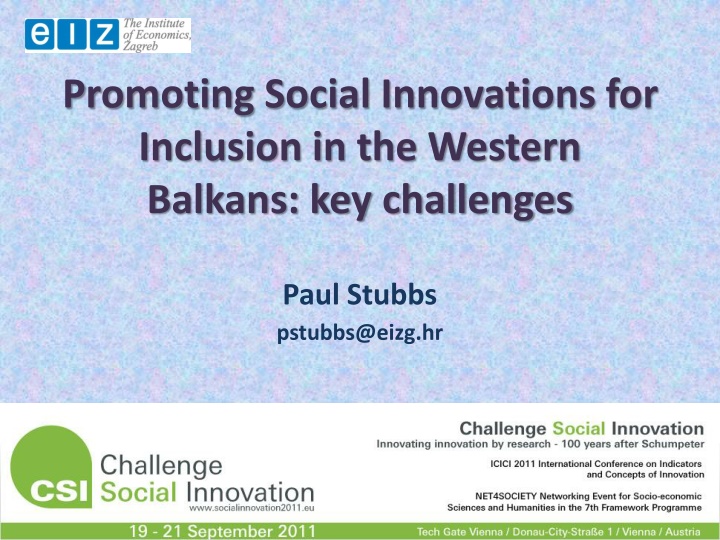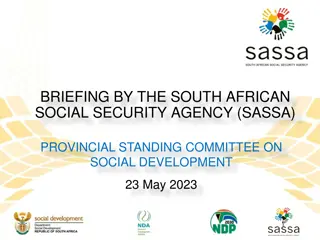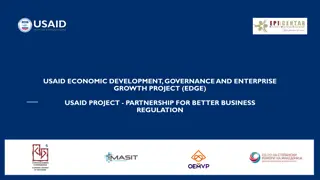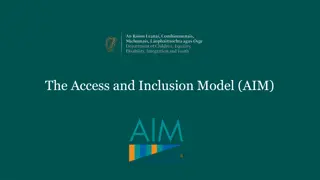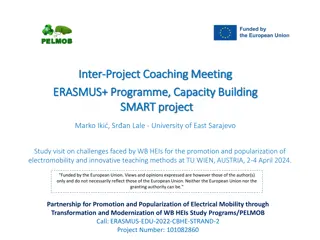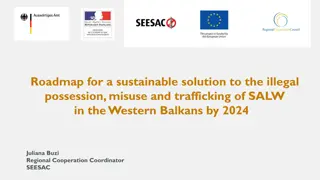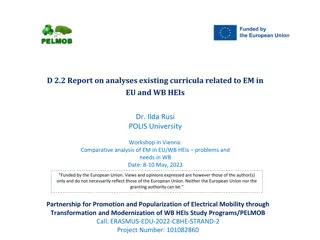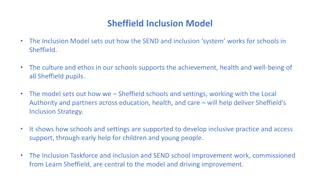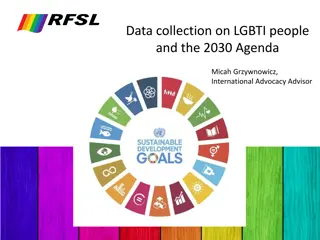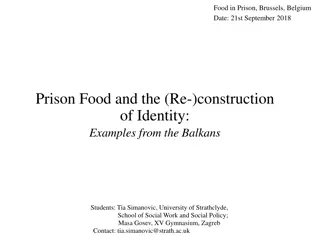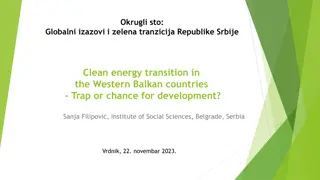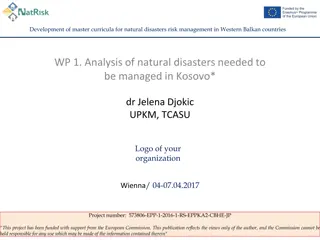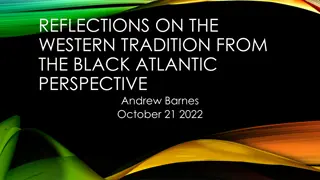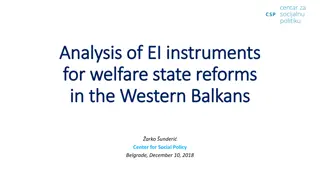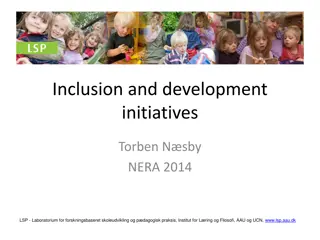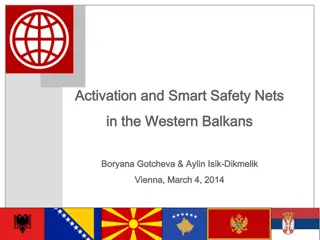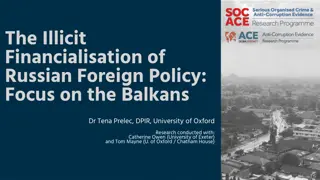Challenges and Solutions for Social Inclusion in the Western Balkans
This presentation discusses key challenges in promoting social innovations for inclusion in the Western Balkans. It explores theories of social exclusion, the rise of a Moral Underclass Discourse, and economic indicators such as GDP growth and absolute poverty headcount. The content emphasizes the need to address structural issues hindering social inclusion and highlights the complexity of tackling diverse forms of exclusion effectively.
Download Presentation

Please find below an Image/Link to download the presentation.
The content on the website is provided AS IS for your information and personal use only. It may not be sold, licensed, or shared on other websites without obtaining consent from the author.If you encounter any issues during the download, it is possible that the publisher has removed the file from their server.
You are allowed to download the files provided on this website for personal or commercial use, subject to the condition that they are used lawfully. All files are the property of their respective owners.
The content on the website is provided AS IS for your information and personal use only. It may not be sold, licensed, or shared on other websites without obtaining consent from the author.
E N D
Presentation Transcript
Promoting Social Innovations for Inclusion in the Western Balkans: key challenges Paul Stubbs pstubbs@eizg.hr
The Presentation 1. On Coats of Paint and MUD 2. Social Exclusion in the Western Balkans 3. Promoting Social Inclusion I: state and market 4. Promoting Social Inclusion II: the social economy 5. Towards Social Innovations for Social Inclusion
A Coat of Paint Theory of Social Exclusion Following Paul Gilroy (1987) on racism: A coat of paint theory of social exclusion sees it as an aberrant or surface feature of society, and therefore easily removed. Seeing social exclusion as an integral part of the way contemporary societies are structured, organised and legitimated, offers a very different perspective. Exploring the institutionalised nature of social exclusion requires understanding how it is embedded in social relations. The challenge is, therefore, to deal with the complex and diverse ways that diverse forms of social exclusion actually work.
A Moral Underclass Discourse Ruth Levitas (1990) expressed concern about the rise of a Moral Underclass Discourse (MUD) at the expense of both a Social Integrationist Discourse (SID) and, in particular, a Redistributive Discourse (RED) Social exclusion is caused by the moral attitudes and cultural practices of those who are excluded Responses to social exclusion may promote dependency and reinforce a cycle of poverty and deprivation Programmes for those capable to work should be conditioned in some way to ensure attitudinal and behavioural change
Western Balkans: Real GDP Growth 2008-2010 (%) 10 8 6 4 Croatia Montenegro 2 Serbia Bosnia 0 Macedonia Kosovo -2 Albania -4 -6 -8 2008 2009 2010 6
Absolute poverty headcount at $5 per day Croatia 2% Bosnia 8% Serbia 17% Macedonia 37% Montenegro 49% Albania 60% Kosovo 82% 0% 10% 20% 30% 40% 50% 60% 70% 80% 90% 7
The Myth of High Social Spending in % GDP for 2008 EU 27 EU 16 44.6% 44.9% 39.3% 46.9% 46.8% 41.5% -2.3% -1.9% -2.3% WB Government Revenue Government Expenditure Fiscal Balance Expenditure by Economic Classification Wage Bill Social Transfers Expenditure by Functional Classification Health Education Social Protection 10.3% 9.9% 20.1% 21.6% 15.5% 9.3% 6.9% 5.2% 18.2% 18.9% 13.0% 6.9% 4.8% 5.6% 4.4% Source: O Mahony RCC 2011, For EU data EUROSTAT and for WB data IMF and EFPs/PEPs
A Varied Fiscal Envelope in % GDP for 2008 EU 27 EU 16 WB Albania BiH Croatia FYRoM Montenegro Serbia 44.6% 44.9% 39.3% 26.8% 46.0% 39.8% 32.5% 46.9% 46.8% 41.5% 32.3% 49.5% 40.7% 33.4% -2.3% -1.9% -2.3% -5.5% -3.5% -0.9% Government Revenue Government Expenditure Fiscal Balance Expenditure by Economic Classification Wage Bill Social Transfers Expenditure by Functional Classification Health Education Social Protection 48.6% 48.8% -0.3% 41.9% 44.5% -2.6% -0.9% 10.3% 9.9% 9.3% 20.1% 21.6% 15.5% 6.1% 12.0% 9.8% 8.6% 15.4% 16.3% 18.9% 5.2% 12.1% 15.9% 10.7% 17.9% 6.9% 6.9% 5.6% 5.2% 4.8% 4.4% 18.2% 18.9% 13.0% 2.5% 3.5% 7.9% 14.9% 13.5% 10.6% 7.1% 5.5% 5.6% 4.1% 6.7% 4.8% 5.8% 4.8% 14.6% 5.7% 3.8% 16.4% Source: O Mahony RCC 2011
Drivers of Social Exclusion Multiple shocks: War/conflicts; Structural transition; Deindustrialisation; Erosion of social capital/solidarities; Captured social policies; Economic and Financial Crisis Distortions caused by locked in expenditures (tertiary health care; residential care) and new (informal) marketization Legacy of category-based (not needs-based) social protection Stigma, discrimination and over-professionalised approaches Political will Fiscal space Technical capacities
Groups At Risk of Exclusion Multi-dimensionality and inter-sectionality of exclusion (n.b. research and data gaps) At risk : (Long-term) Unemployed; Older people; Large families; Women; Children; Youth; Low education levels; RDPs; Minorities (esp. Roma but also national minorities and small minorities ); People with Disabilities; People with long-term health issues; Migrants/returnees/left behind Spatial dimension: Arc of exclusion; Rural Urban; Zones of exclusion New survival strategies eroding long-term capabilities?
Social Innovation: the new magic bullet Social innovation is an important new field which should be nurtured. It is about tapping into the ingenuity of charities, associations and social entrepreneurs to find new ways of meeting social needs which are not adequately met by the market or the public sector. ... As well as meeting social needs and tackling societal challenges, social innovations empower people and create new social relationships and models of collaboration. They are thus innovative in themselves and good for society s capacity to innovate. Europe 2020 Flagship Initiative COM (2010) 546, October
Promoting Social Inclusion: the state/public sector The role of the state: public goods bloated bureaucracy clientelistic rent seeker? Post-Yu countries Centres for Social Work Governance poor horizontal and vertical co-ordination Regulation - over legalistic but with many gaps Human resources - limited skills to meet new social risks Funding - low and inconsistent; little support for non-state actors/providers Strategy too many strategies; too little participation; no real M&E; too influenced by international organisations (nb JIM/JAP process)
Promoting Social Inclusion: the market Few incentives for private, for-profit providers (health, education, social services, ...) Some development of Corporate Social Responsibility: move from philanthropy to sustainable partnerships Growth of market ideas within the public sector (new public management) Informal marketization / commodification of public goods /privatization of public space
Promoting Social Innovation: NGOs Inverse care law NGOs where they are needed least Time-limited, donor-driven funding Service provision at the expense of advocacy and empowerment? Projectisation and endless pilot projects The new project class and the rise of the meta- NGO Innovations are very rarely scaled up or rolled out
Promoting Social Innovation: social entrepreneurship Lack of definition, understanding and legal framework Donor-driven model with policy transfer (CEE - > SEE) Implicit or explicit neo-liberal agenda SE from below green, gender, informal networks, etc New social energy disability advocacy coalitions
Towards Social Innovations for Soial Inclusion I Inclusive labour markets (disability; age; gender) and improved returns to education (life-long learning; skills; transitioning e.g school to work) Holistic and integrated child and family policies (early childhood interventions; universal child benefits; family support services) Deinstitutionalisation and minimum basket of community-based services Social pensions within active ageing policies Anti-discrimination laws and practices Area-based approaches/Action zones
Towards Social Innovations for Soial Inclusion II Support for evidence-based policy making Strategic Goals; Benchmarks; Indicators; M&E; Impact Assessment (including all stakeholders) Enhanced social dimension of IPA programming Regional cooperation (modelling OMC-JIM; Peer review/peer learning; common concerns; RCC as bridge to EU/global frameworks?)
